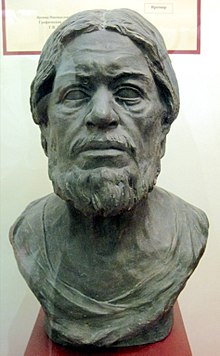| Samuel | |
|---|---|
| Tsar of Bulgaria | |
 Facial reconstruction based on his remains | |
| Reign | 997 – 6 October 1014 |
| Predecessor | Roman |
| Successor | Gavril Radomir |
| Died | 6 October 1014 Prespa,[1] First Bulgarian Empire |
| Spouses | Agatha |
| Issue | Gavril Radomir Miroslava |
| Dynasty | Cometopuli |
| Father | Nicholas |
| Mother | Ripsimia of Armenia |
| Religion | Bulgarian Orthodox |
Samuel (also Samoil[2] or Samuil; Bulgarian: Самуил, pronounced [sɐmuˈiɫ]; Macedonian: Самоил/Самуил,[3][4] pronounced [samɔˈiɫ/sɐmuˈiɫ]; Old Church Slavonic: Самоилъ; died 6 October 1014) was the Tsar (Emperor) of the First Bulgarian Empire from 997 to 6 October 1014.[5] From 977 to 997, he was a general under Roman I of Bulgaria,[6] the second surviving son of Emperor Peter I of Bulgaria, and co-ruled with him, as Roman bestowed upon him the command of the army and the effective royal authority.[7] As Samuel struggled to preserve his country's independence from the Byzantine Empire, his rule was characterized by constant warfare against the Byzantines and their equally ambitious ruler Basil II.
In his early years, Samuel managed to inflict several major defeats on the Byzantines and to launch offensive campaigns into their territory.[8] In the late 10th century, the Bulgarian armies conquered the Serb principality of Duklja[9] and led campaigns against the Kingdoms of Croatia and Hungary. But from 1001, he was forced mainly to defend the Empire against the superior Byzantine armies. Samuel died of a heart attack on 6 October 1014, two months after the catastrophic battle of Kleidion. His successors failed to organize a resistance, and in 1018, four years after Samuel's death, the country capitulated, ending the five decades-long Byzantine–Bulgarian conflict.[10]
Samuel was considered "invincible in power and unsurpassable in strength".[11][12] Similar comments were made even in Constantinople, where John Kyriotes penned a poem offering a punning comparison between the Bulgarian Emperor and Halley's comet, which appeared in 989.[13][14] During Samuel's reign, Bulgaria gained control of most of the Balkans (with the notable exception of Thrace) as far as southern Greece. He moved the capital from Skopje to Ohrid,[8][15] which had been the cultural and military centre of southwestern Bulgaria since Boris I's rule,[16] and made the city the seat of the Bulgarian Patriarchate. Because of this, his realm is sometimes called the Western Bulgarian Empire.[17][18] Samuel's energetic reign restored Bulgarian might on the Balkans, even though the Empire was disestablished after his death.
- ^ Southeastern Europe in the Middle Ages, 500–1250, Florin Curta, Cambridge University Press, 2006, ISBN 0521815398, p. 242.
- ^ Spelled thus in Fine, The Early Medieval Balkans; also Ostrogorsky, Treadgold, opp. cit., Oxford Dictionary of Byzantium. In French, compare Adontz, Nicholas. "Samuel l'Armenien, Roi des Bulgares", in Études Arméno-Byzantines. Lisbonne: Livraria Bertrand, 1965, pp. 347–407.
- ^ Македонска енциклопедија, том II. Скопје, Македонска академија на науките и уметностите, 2009. ISBN 978-608-203-024-1. стр. 1296
- ^ Stojkov, Stojko (2014) Крунисувањето на Самуил за цар и митот за царот евнух. Гласник на институтот за национална историја, 58 (1–2). pp. 73–92. ISSN 0583-4961.
- ^ A History of the Byzantine state and society, Warren Treadgold, Stanford University Press, 1997, ISBN 0804726302, p. 871.
- ^ Anthony Kaldellis, Streams of Gold, Rivers of Blood: The Rise and Fall of Byzantium, 955 A.D. to the First Crusade, Oxford University Press, 2017, ISBN 0190253223, p. 82.
- ^ One theory is that from 972/976 to 997 Samuel co-ruled with Roman I of Bulgaria, who was the official tsar until 997, when he died in Byzantine captivity. Roman is mentioned as tsar in several historical sources; for example the Annals by Yahya of Antioch call Roman "Tsar" and Samuel "Roman's loyal military chief". However, other historians dispute this theory, as Roman was castrated and so technically could not have claimed the crown. There was also a governor of Skopje called Roman who surrendered the city to the Byzantines in 1004, receiving the title of patrician from Basil II and becoming a Byzantine strategos in Abydus (Skylitzes-Cedr. II, 455, 13), but this could be a mere coincidence of names.
- ^ a b "Samuil of Bulgaria". Archived from the original on 21 February 2007. Retrieved 23 May 2008.
- ^ "Britannica Online – Samuel of Bulgaria". Retrieved 23 May 2008.
- ^ Whittow, Making of Orthodox Byzantium, pp. 387–388.
- ^ Stephenson, P., The legend of Basil the Bulgar-slayer, p. 16, ISBN 0-521-81530-4
- ^ Sullivan. D. F., ed. and tr., The life of St Nikon, Brookline, 1987, pp. 140–142.
- ^ Cite error: The named reference
poewas invoked but never defined (see the help page). - ^ Schlumberger, G, L'épopée byzantine á la fin de dixiéme siécle, 1. Jean Tzimisés; les jeunes années de Basile II, le tueur de Bulgares (969–989), Paris 1896, pp. 643–644.
- ^ Cite error: The named reference
encwas invoked but never defined (see the help page). - ^ "About Ohrid". Retrieved 23 May 2008.[dead link]
- ^ The Decline and Fall of the Roman Empire, Edward Gibbon, J. B. Bury, Wildside Press LLC, 2004, ISBN 0-8095-9240-1, p. 142.
- ^ A short history of Yugoslavia from early times to 1966, Stephen Clissold, Henry Clifford Darby, CUP Archive, 1968, ISBN 0-521-09531-X, p. 140